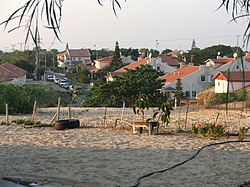You can help expand this article with text translated from the corresponding article in Russian. (April 2024) Click [show] for important translation instructions.
|
Neve Dekalim (Hebrew: נְוֵה דְּקָלִים, lit. 'Oasis of Palms') was an Israeli settlement in the Gaza Strip. Comprising a part of Gush Katif, it was founded in 1983, shortly after Israel withdrew from the Sinai Peninsula to fulfill the Egypt–Israel peace treaty. It served as a regional centre for the Gush Katif settlement bloc and was the seat of the defunct Hof Aza Regional Council. The settlement was located in between the Mediterranean Sea and the Khan Yunis refugee camp.[1] In August 2005, Neve Dekalim was dismantled by the Israeli government in pursuit of the Disengagement Plan Implementation Law, which had been approved by the Knesset six months earlier.
Neve Dekalim
נְוֵה דְּקָלִים | |
|---|---|
 | |
| Etymology: Oasis of Palms | |
Location within the Palestinian Territories | |
| Coordinates: 31°21′24″N 34°16′30″E / 31.35667°N 34.27500°E | |
| Country | |
| Council | Hof Aza Regional Council |
| Region | Gaza Strip |
| Founded | 1983 |
| Population (2001) | 2,600 |
History
The population consisted of about 520 families (2,600 people), mainly Orthodox Jews. It was the largest Israeli settlement in the Gaza Strip and a commercial centre for the region.[2] The industrial zone of Gush Katif was located in Neve Dekalim.[citation needed]
During the Second Intifada, some 6,000 mortars and Qassam rockets were fired at Neve Dekalim by Palestinian militants.[3] In July 2005, shortly before the Israeli disengagement plan was implemented, two Neve Daklim residents were injured by Palestinian mortar strikes.[4]
Dismantling
The evacuation of Neve Dekalim began on 15 August, as part of the Israeli disengagement plan, and was completed on 18 August.[5] The residents were given 48 hours to leave. Those who refused to leave voluntarily barricaded themselves in the settlement's synagogue, but were forcibly removed by the Israel Defense Forces and the Israel Police.[6]
The homes were bulldozed by Israel after the residents were evacuated, leaving only the greenhouses, which were part of a transaction in which private American citizens bought them for the Palestinians.[citation needed] Despite the presence of Palestinian security guards, dozens of these greenhouses were looted by Palestinian residents.[7]
Marching through the abandoned town in a "victory parade," Hamas gunmen fired in the air and trampled an Israeli flag.[8]
It was the largest Israeli settlement in the Gaza Strip.[citation needed] Signs posted in Arabic state that it is a "closed military zone." Mahmoud al-Zahar, chief of Hamas, said that Hamas planned to launch attacks that would drive Jews out of the West Bank and from the entire Jewish state.[citation needed]
In 2010, the site of Neve Dekalim was mostly sand and rubble, with Palestinian trucks removing the last remnants of Israeli homes for use as construction material.[9] In Israel, former residents of the settlement established a new village, Bnei Dekalim.
In popular culture
Neve Dekalim is featured in the movie Disengagement by Amos Gitai. Grains Of Sand: The Fall Of Neve Dekalim by Shifra Shomron, a former resident of Neve Dekalim, is a semi-autobiographical novel about an Israeli family evacuated from Gush Katif.[10]
References
- ^ "Settlements seen across the divide". BBC. 20 June 2005. Archived from the original on 8 August 2014. Retrieved 23 July 2014.
- ^ "Israeli zoo poised to evacuate animals". Archived from the original on 2014-02-02. Retrieved 2013-01-08.
- ^ "Waiting for a miracle". Archived from the original on 2022-05-13. Retrieved 2022-05-13 – via The Economist.
- ^ "Violence flares up in Gaza Strip". July 17, 2005. Archived from the original on November 18, 2011. Retrieved January 4, 2012 – via news.bbc.co.uk.
- ^ "CNN.com - Largest Gaza settlement evacuated, Israel says - Aug 18, 2005". www.cnn.com. Archived from the original on May 24, 2007. Retrieved February 23, 2007.
- ^ Reporters, Ynet (August 17, 2005). "Clashes, tears in Neve Dekalim". Archived from the original on May 13, 2022. Retrieved May 13, 2022 – via www.ynetnews.com.
- ^ "Looters strip Gaza greenhouses". NBC News. Archived from the original on 2022-05-13. Retrieved 2022-05-13.
- ^ "Hamas celebrates Gaza pullout - Boston.com". Archived from the original on 2012-07-07.
- ^ "Settlers and Palestinians remember 2005 Gaza pullout". August 17, 2010. Archived from the original on May 13, 2022. Retrieved May 13, 2022 – via www.bbc.co.uk.
- ^ "Grains of Sand: The Fall of Neve Dekalim". Archived from the original on 2019-01-19. Retrieved 2017-09-06.
